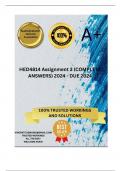,HED4814 Assignment 3 (COMPLETE ANSWERS) 2024 -
DUE 2024 ; 100% TRUSTED Complete, trusted solutions
and explanations.
QUESTION 1. Psychosocial Support and Emotional-
Behavioural Interventions (25 marks) a) Explain the concept of
psychosocial support in an educational context. (5 marks) b)
Discuss three evidence-based strategies for providing emotional
support to students in a classroom setting. (10 marks) c)
Describe a behavioural intervention approach of your choice and
explain how it can be implemented to address challenging
behaviours in the classroom. (10 marks)
Here’s a structured response to Question 1, focusing on
psychosocial support and emotional-behavioral interventions in
an educational context.
QUESTION 1: Psychosocial Support and Emotional-
Behavioural Interventions
a) Explain the concept of psychosocial support in an
educational context. (5 marks)
Answer: Psychosocial support in an educational context refers
to a range of services and interventions aimed at promoting the
psychological well-being and social development of students. It
involves creating a safe and nurturing environment where
students feel valued, understood, and connected to their peers
and teachers. This support can encompass various strategies,
including emotional assistance, social skills development, and
interventions to address the mental health needs of students.
, In educational settings, psychosocial support is essential for
helping students cope with challenges such as academic stress,
family issues, and social dynamics. It fosters resilience,
enhances self-esteem, and encourages healthy relationships
among students, contributing to a positive school climate. The
integration of psychosocial support into the curriculum and
school culture allows educators to address the holistic needs of
students, ensuring their emotional, social, and academic growth.
b) Discuss three evidence-based strategies for providing
emotional support to students in a classroom setting. (10
marks)
Answer:
1. Cognitive-Behavioral Techniques (CBT):
Cognitive-behavioral techniques help students identify and
modify negative thought patterns and behaviors. Educators
can incorporate CBT strategies into classroom discussions
by guiding students through exercises that promote self-
reflection, problem-solving, and goal setting. For instance,
teachers can use “thought logs” to encourage students to
track their feelings and thoughts related to specific
situations. This practice helps students develop emotional
awareness and resilience, enabling them to cope better with
stressors.
2. Peer Support Programs:
Peer support programs involve training students to provide
emotional assistance to their classmates. These programs
foster a sense of community and help create a supportive
environment. For example, schools can establish “buddy
systems” where older students mentor younger ones,




